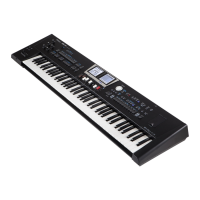Menu options
128
1. Rotate the dial to move the cursor on the “Keyboard Part”
eld. Use the [INC] or [DEC] button to select the keyboard
part you want to edit UP1 (Upper1), UP2 (Upper2), LWR
(Lower), MBAS (Manual Bass).
The display shows the settings for the selected keyboard part.
2. Select and set the desired parameter(s). See “Browsing
Windows and Setting Parameter Values” (p. 26).
The following parameters are available:
Tone
Allows you to select a dierent Tone. While selecting a Tone, you
can press a Tone selection button to select a dierent family.
Parameter Explanation
Tone The number of Tones depends on the selected family
Volume
Adjusts the volume of the selected keyboard part.
Selecting “0” means that the part in question is no longer audible.
Parameter Setting
Volume 0~127
MEMO
You can also adjust the volume of the keyboard parts using
the sliders. See “Setting the Volume of the Real-Time Parts or
Rhythm Parts (Mixer)” (p. 33).
Reverb Send
Use this parameter to set the reverb send level (i.e. the amount of
eect that should be added).
Parameter Setting
Reverb Send 0~127
Chorus Send
Use this parameter to set the chorus send level (i.e. the amount of
eect that should be added).
Parameter Setting
Chorus Send 0~127
Panpot
Use this parameter to change the stereo placement of the selected
keyboard part. “L63” means “hard left” and “R63” represents “hard
right”. Choose “0” if the sound should be at the center of the stereo
image.
Parameter Setting
Panpot L63~0~R63
Key Touch (velocity sensitivity)
The BK-9’s keyboard is velocity sensitive, allowing you to control the
timbre and volume of the keyboard parts by varying the strength
with which you strike the keys.
1. If you want to edit this setting, you have to push the dial
to select the “Key Touch” page.
Right Display
2. Select and set the desired parameter(s). See “Browsing
Windows and Setting Parameter Values” (p. 26).
The following parameters are available:
Parameter Setting Explanation
Curve
High, Medium,
Low, Fixed*
• “High”:
Select this setting for maximum expressive-
ness. Even small variations of the force with
which you strike a key produce audible
changes. The trade-o is, however, that you
have to strike the keys forcefully to reach
the maximum volume.
• “Medium”:
Medium velocity sensitivity. The keyboard
responds to velocity changes, but the
maximum volume can be obtained more
easily than the with “high” curve. (This is the
default setting.)
• “Low”:
Select this setting if you are used to playing
on an electronic organ or if you do not
want velocity changes to bring about major
volume changes.
• “Fixed”:
Select this setting if all notes you play on
the keyboard should have the same veloc-
ity value. When you set this parameter, the
“Fixed value” eld can be edited.
Min Value 1~127
This parameter allows you to set the
smallest velocity value with which you can
trigger the selected part.
Max Value 1~127
This parameter allows you to set the
highest velocity value with which you can
trigger the selected part.
Fixed value* 1~127
Allows you to set the value when “Curve” is
set to “Fixed”.
[*] This parameter can only be edited if the “Curve” parameter is set
to “Fixed”.
Eq Part Edit
1.
If you want to edit the parameters of the equalizer, you
have to push the dial to select the “Eq Edit Part” page.
Right Display
2. Select and set the desired parameter(s). See “Browsing
Windows and Setting Parameter Values” (p. 26).

